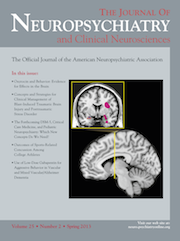Corticobasal Syndrome Presenting With Partial Gerstmann’s Syndrome and Digit Agnosia
To the Editor: Gerstmann’s syndrome (GS) is a clinical picture characterized by finger agnosia, left–right confusion, agraphia, and acalculia, associated with focal left posterior-inferior parietal lesions.1 Partial presentations of GS have been reported in neurodegenerative diseases,2,3 as we describe in a patient presenting with GS and digit agnosia as early symptoms.
A 62-year-old, right-handed woman, with 8 years of formal education, came to our attention because of mild cognitive difficulties involving limb praxis. The neurological examination detected upper limb tremor, more left-lateralized; global bradykinesia; rigidity of left limbs; bilateral focal myoclonus, stimulus-sensitive, more evident on the left limbs; and gait apraxia; the alien limb phenomenon was not present. Instrumental examinations detected bilateral temporo-parietal alterations (EEG), cortical atrophy (RMI), bilateral hypometabolism in the frontal-temporal-parietal cortices, and bilateral striatal degeneration (DAT-SCAN).
The neuropsychological assessment detected executive difficulties, impaired visuospatial functions, and bilateral ideomotor limb apraxia, and therefore focused on GS. The patient showed finger agnosia (Two-Point Finger test,1 Finger Agnosia test,1 In-Between test)1 and toe agnosia;4 that is, digit agnosia. She also presented acalculia (being unable to count backward from 10 to 0 and perform multiplication tables), Left–Right Confusion (3/5 in the two-stage command1 and 2/5 in relation to experimenter body) and agraphia (5/20 correct words in dictation; no signs of alexia), although limb motor difficulties hampered its examination.
Although only a pathological examination could confirm the clinical diagnosis, her clinical picture was suggestive of a parkinsonism, probably a corticobasal syndrome (CBS); a progressive neurodegenerative disease with atrophy, gliosis, and tau-immunoreactive pathology of both gray and white matter of neocortex, basal ganglia, and substantia nigra, and clinically characterized by asymmetric akinesis and rigidity; dystonia of the upper limb; apraxia, myoclonus, and dementia.5
The neuropsychological assessment evidenced digit agnosia and at least a partial GS; indeed, although her limb motor difficulties hampered the examination of agraphia, it appeared likely. Interestingly, the neuropsychological pattern of CBS partially overlaps the clinical presentation of GS as regards acalculia, number processing, and agraphia, and both CBS and GS are associated with parietal lesions.1,5 Despite their possible phenotypic overlapping, only two cases of pathologically-confirmed corticobasal degeneration and partial presentation of GS have been described.2 The current study confirmed that GS, including digit agnosia, may characterize the early clinical stages of a neurodegenerative disease affecting parietal lobes, as CBS.
1 : The enigma of Gerstmann’s syndrome revisited: a telling tale of the vicissitudes of neuropsychology. Brain 2010; 133:320–332Crossref, Medline, Google Scholar
2 : The Gerstmann syndrome in Alzheimer’s disease. J Neurol Neurosurg Psychiatry 2002; 72:403–405Crossref, Medline, Google Scholar
3 : Pathologically confirmed corticobasal degeneration presenting with visuospatial dysfunction. Neurology 2003; 61:1134–1135Crossref, Medline, Google Scholar
4 : Toe agnosia in Gerstmann syndrome. J Neurol Neurosurg Psychiatry 1997; 63:399–403Crossref, Medline, Google Scholar
5 : Corticobasal degeneration. Lancet Neurol 2004; 3:736–743Crossref, Medline, Google Scholar



